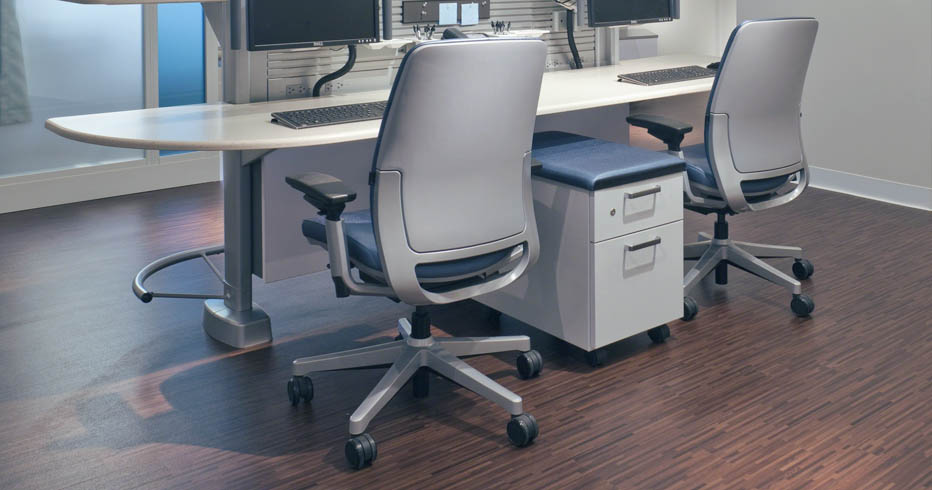The Best Office Chairs for Short People – Comfort and Ergonomics for Every Height

Quick Overview of Key Points
An adjustable office chair is ideal for any size person. Smaller chairs designed with lower seat heights, or cushions to raise the height of standard chairs, are good options for shorter people.
Identifying the Optimal Office Chair for a Short Person
When it comes to finding an office chair for a short person, comfort and ergonomics should be of primary importance. As potential buyers explore different types of chairs, there are a few key features that should be taken into consideration.
One of the most crucial elements to examine when considering an office chair for a short person is the size of the seat. A seat should be wide enough to provide ample support to the thighs but small enough that it doesn’t overpower a smaller body frame. Additionally, look for a chair with ample lower back support and adjustable armrests so that they can be adapted to an individual’s height.
Then there are issues such as tilt tension and seat dip. Tilt tension is how much force must be applied by an individual in order to recline the chair, which allows for greater ease and more precise adjustments for those with shorter heights. As for seat dip, it refers to how deep the seat is from front-to-back when fully lowered. The higher the dip, it could mean more comfort for a shorter person than one with less which may result in their legs hanging off the edge of the chair.
Whether opting for manual or electric models, there are pros and cons to both sides and ultimately this decision depends on personal preference and budget. Manual chairs tend to be cheaper than electric models; however, electric models usually have more features like lumbar support, adjustable head and foot rests allowing one to find their perfect level of comfort easily even if they don’t fit within standard measurements.
Ultimately when selecting the optimal office chair for the short person, comfort and ergonomics should remain a priority while also taking other factors such as size, adjustment functions and cost into account. By doing so, individuals can find exactly what best suits their needs.
With this knowledge in mind, let us now take a closer look at the types of office chairs available that may be suitable for people of shorter stature looking to make sure they achieve maximum comfort while working or studying in an office setting.
- A study conducted in 2017 found that sitting in an ergonomic office chair increased comfort and reduced strain on the lower back for individuals of all sizes.
- According to an article published by The Spine Health Institute, adjustable seats with lumbar support are ideal for shorter people as they can easily be adjusted to fit the user’s height and posture.
- According to a study conducted in 2019, using an office chair designed especially for short people can significantly reduce back pain in those who are 5’2″ or shorter.
Types of Office Chairs to Consider
When shopping for the best office chair, it’s important to consider a number of different types of chairs. Depending on the intended use and the size of the person using it, there may be a variety of different chairs that will work for an individual.
The most common type of office chair is the classic swivel chair, with five-point caster wheels and adjustable heights. Swivel chairs are comfortable and offer freedom of movement, which makes them a viable option for short people who may need to make sudden movements or switch positions often. On the other hand, this type of chair does have its drawbacks, as it can lack lumbar and neck support for long periods at a time, potentially making it uncomfortable for someone who spends much of their day sitting in it.
Alternatively, office stools are gives short people more reliable foot support while they sit, but they generally don’t come with any back or arm rests. Additionally, they usually aren’t adjustable in height and typically tilt backward at various angles, so if height isn’t an issue, a user still needs to ensure that the stool tilts in a position suitable for them. Adjustable drafting chairs may be suitable when ergonomics really matter since they can come with extra features like adjustable armrests or built-in back support and moveable parts like slideable seat plates; this type of chair works especially well if you need to also stand throughout your workday.
Before buying any specific office chair, it’s important to carefully consider the intended use and budget constraints. All types have some pros and cons unique to their design that must be taken into account before purchase. With this knowledge in mind, let’s look further into adjustable office chairs and how adding additional adjustability points can affect comfort for short people in particular.
Adjustable Office Chairs
Adjustable office chairs are an attractive option for finding the perfect fit for short people. These chairs allow you to customize the seat height and adjust the armrests, lumbar support, and tilt tension to ensure comfort when sitting.
The benefit of adjustable office chairs is that they allow people of all stature, including shorter individuals, to find a chair that meets their needs. Whether someone wants a lower seat height or extra back support, adjustable office chairs can be outfitted with a variety of customizable features to make sure each user has the best ergonomic setup to tackle tasks throughout their day.
However, depending on the model and price range, adjustable office chairs might not efficiently meet certain user requirements. Some may be too low for taller users or unlikely to provide sufficient lower back support for larger individuals. Additionally, it can be difficult to make adjustments with some models since the knobs and levers are not always easy to use.
Overall, adjustable office chairs offer an excellent choice for short people seeking comfortable seating with optimal ergonomics. They can frequently be purchased at a fraction of the cost of standard ergonomic models and can be found in a variety of styles and designs. With careful consideration and research into model specifications, short people can likely find an adjustable chair that works for their needs.
To ensure even greater comfort and ergonomics, it is worth considering ergonomic office chairs. In the next section, we will look at what makes ergonomic office chairs special – something both tall and short users should keep in mind!
Ergonomic Office Chairs
Ergonomic office chairs are designed to provide comfortable, personalized support for extended periods of seated work. The basic idea is that by customizing the chair to fit a person’s body, they can not only prevent aches and pains associated with poor posture, but also increase productivity. Many ergonomic office chairs feature adjustable seat height, tilt, armrests and lumbar support. Each of these adjustments allow the user to create a personalized position that helps minimize physical strain while working.
The benefit of ergonomic office chairs is that they can often be tailored to an individual’s body, promoting better posture and comfort. In addition, many ergonomic chairs can help to reduce back pain due to their design. Some people argue that the added cost of an ergonomic office chair is worth it for the health benefits alone.
On the other hand, some experts contend that all office chairs should be designed to provide adequate support without having to resort to expensive ergonomic chairs. Furthermore, there are studies which suggest that ergonomic chairs do not provide any more benefits than regular office chairs and may even cause additional discomfort if used wrongly or in an unsuitable manner.
Regardless of the debate over its actual benefits, most experts agree that a good ergonomically designed office chair can maintain one’s comfort and posture throughout the workday. Therefore, when selecting an office chair for short people, it might be wise for them to consider an ergonomic option for maximum support and comfort.
Next, this article will discuss the various factors to consider when choosing an office chair for a short person.
Factors to Consider When Choosing an Office Chair for a Short Person
When choosing an office chair for a short person, there are a few important factors to consider. Firstly, it is important to make sure the chair fits appropriately for your height and body shape. The overall chair size should be considered. If the chair is too high or too low it can cause strain on the neck, shoulders, and lower back. Ideally, the seat of the chair should be deep enough for your thighs to fit in comfortably with arms resting at roughly shoulder width to support you while seated. Additionally, adjustable features such as tilt tension and lumbar support can also add extra comfort when sitting in an office chair all day long.
The amount of adjustable options can add a lot of value to the ergonomic experience of a short-statured individual looking for the right office chair. For example, having the ability to adjust the height is essential because it will ensure that feet are planted firmly on the floor when seated properly at an angle that supports proper posture. Moreover, being able to make adjustments regarding arm height will give user’s additional support throughout their working hours without straining their neck and shoulders. On the other hand, tall people may find this adjustment unnecessary as they have more natural support.
Finally, its best to select a comfortable material which ideally shouldn’t feel too rugged on bare skin once seated in it for extended periods of time. Now that we have discussed factors to consider when choosing an office chair for short people, it’s important to move on to how one can further refine their search by exploring the topic of height adjustment in greater detail.
Top Highlights
When selecting an office chair for a short person, it is important to consider ergonomic factors such as an appropriate size, adjustable features such as tilt tension and lumbar support, and comfortable material. Specifically, making sure the chair is an appropriate height is essential as it can help provide good posture and ensure feet are planted firmly on the floor. Additionally, adjustable arm height gives users extra support without straining their neck and shoulders. It’s also important to select a comfortable material which doesn’t feel too rugged against skin. Finally, exploring the topic of height adjustment in greater detail can further refine one’s search for the perfect office chair.
Height Adjustment
Height adjustment is an important factor to consider when selecting an office chair, particularly for those of smaller stature. It allows the user to customize their seating experience and make sure that their feet are firmly planted on the ground. This ensures proper posture, alleviates lower back strain and enables comfortable sitting over long periods of time.
Also known as “seat depth adjustment,” this feature can typically be found on modern chairs and allows users to alter the distance between the back edge of the seat and the front edge. Seat depth helps shorter people keep their feet flat on the floor and sit in a more upright position, thus reducing any potential discomfort due to incorrect posture. Ideally, when seated in the chair with the right amount of seat height, the user will be able to rest their arms naturally on the armrests while working.
Depending on the height of each individual user and type of chair they prefer, different modes of adjusting chair heights may be beneficial. Some models come with adjustable foot ring or platform surfaces that allow for height adjustments by raising or lowering them depending on what feels most comfortable. Others may come with multiple levers that enable users to increase or reduce seat pan tension during use. This allows them to adjust how far forward or backward their thighs move in relation to their bottom position when sitting down.
The argument for adjustable chairs versus non-adjustable chairs is clear: adjustable office chairs provide short people with an ergonomic design for better comfort compared to traditional office chairs and other seating solutions that have a fixed height frame. Despite greater potential for costlier repair and maintenance due to wear over time (e.g., worn gas cylinders, warped lumbar support bars), adjustable chairs generally offer a longer lifespan in comparison to non-adjustable types, allowing adjustable chairs to yield a higher return on investment in terms of useful life span versus cost factors.
Not all adjustable office chairs are created equal though – some models may not be appropriate for smaller figures due to a lack of certain features or incorrect sizes, such as armrests that may be too far apart and headrests that may be too low or high making it difficult for shorter people get into an optimal sitting posture and cause fatigue quickly. For this reason it’s important for short people take notice of all these details before making any purchase decisions so they can find one that fits perfectly according to the buyer’s size and needs.
Finally, taking note of height adjustment measures then checking against user comfort (in terms of body proportions) should provide insight into which model might work best for each particular person desiring an ergonomic fit. With this knowledge in hand, it’s now easier than ever for every buyer – regardless of size – to select an office chair tailored especially for them which importantly takes into account both seat height and ergonomic design choices.
Next we’ll discuss how ergonomic design elements integrated into office chair frameworks can produce superior comfort levels across different body types and sizes without compromising personal health risks due to poor posture positioning while seated at a desk all day long.
Ergonomic Design
When considering ergonomic design in an office chair, there are various key elements to take into account, no matter what size of person will be sitting in it. Ergonomically designed chairs should promote better posture and comfort for the user, as well as provide lumbar support with adjustable heights. Chair arms, back upholstery, lumbar support options, materials used and overall aesthetic, can all contribute to an ergonomically designed chair being suitable for a wide range of people.
These key components can also be adjusted or altered to accommodate different body types and sizes. For example, adjustable arms allow short people to bring the arms closer to their body and therefore reduce any potential side strain as they type. Likewise tall people may require more distance between their arms and body to ensure their elbows are supported correctly. Upholstery is another important factor when considering ergonomic design; mesh or synthetic seating systems which keep the body temperature regulated may be preferable instead of leather or vinyl which can become hot and uncomfortable relatively quickly.
Perhaps the most significant factor of maintaining a good ergonomic design is ensuring the right level of lumbar support. People of slightly smaller stature often struggle to find office chairs that fit their back without having a large gap at the base of their spine. Therefore, curved back rests which are slightly tilted towards the lower back may be preferable but ultimately need to be adjustable by height so that both short and tall people alike are well supported throughout their working day.
Ergonomic design should be paramount when choosing an office chair so observing each of these elements carefully is essential when making a purchase decision. With that in mind, let us now look at what might make the best office chair for a short person many factors coming together for one perfect sit.
The Best Office Chair for a Short Person
The best office chair for a short person is one that comes with adjustable features so that it can be tailored to their specific size and needs. A good chair should provide plenty of lumbar support, adjustment options for both the seat and backrest, and a well-cushioned sitting area that fits comfortably around the hips and upper thighs. Additionally, a quality chair should also allow you to make adjustments to the height of the arms in order to offer better arm support while typing.
When it comes to finding an ergonomic office chair for a shorter frame, it can be beneficial to seek out chairs with adjustable features. Many manufacturers now offer chairs specifically designed for smaller users with adjustable features such as seat height and arm rests so that you stay comfortable throughout your workday. While these specialized models might cost more upfront than regular office chairs, they are an investment worth making if it promotes proper ergonomics and comfort for long-term use.
On the other hand, taller people may find it difficult to fit into a chair designed specifically for a shorter user, as there is less room for adjustments. Many times, taller individuals will benefit more from going up one size class in terms of office chairs. It might also be necessary to add a foot rest to achieve additional support on larger chairs.
In any case, choosing the right office chair is essential when it comes to finding one that fits your body type and provides the necessary support during long work hours. In the next section, we’ll discuss how to go about choosing the perfect office chair for your situation.
Choosing the Perfect Office Chair
Choosing the perfect office chair for short people is a crucial step towards maintaining a healthy work-life balance, as well as avoiding unnecessary pain, aches and strains. Ergonomic chairs are specifically designed to provide optimal comfort and support, allowing even those of shorter stature to remain comfortable throughout the day. When looking for an ideal chair, it is important to consider the various features available and how they can benefit specific needs.
The first step when shopping for a chair is to identify what is most important and conducive to one’s individual working style. Some may value comfort above all else, while others may prefer ergonomics and adjustability. The seat height should be adjustable as this is one of the main determining factors in how comfortable someone of short stature feels when sitting in a chair over long periods of time. Furthermore, having adequate lumbar support with adjustable tilt tension helps ensure that your back maintains an upright posture throughout the day, reducing possible strain on your body from hunching over or slouching.
When debating which features take priority there are both advantages and disadvantages to different styles of chairs. In terms of style, more traditional office chairs have small form factor designs which feature fixed height arms and seat backs which are not adjustable. However, these offer great cost effectiveness and may satisfy only casual users who don’t require additional adjustability or need lumbar support very often. On the other hand, modern ergonomic chairs feature adjustable arm rests, seat heights, tilt tensions and much more elaborate back supports – providing superior customization capabilities perfect for users who require a higher level of comfort or particular adjustments based on their physical needs due to shorter stature.
Ultimately, the right office chair will depend heavily on personal preferences and needs as well as budget constraints – but regardless of what type of chair you choose to go with making sure it fits your body size properly will ensure maximum comfort without sacrificing ergonomics or healthy postural posture throughout the working day.
Frequently Asked Questions Answered
What are the advantages and disadvantages of various office chairs for short people?
The advantages and disadvantages of various office chairs for short people will depend largely on the type of chair and user’s individual needs. Generally, ergonomically designed office chairs are great options for all body types as they are designed to provide optimal support and comfort. For short people, specifically, adjustable seat height can reduce pressure on your legs while kneeling and sitting to increase comfort. Adjustable lumbar support helps maintain a healthy posture by providing additional back and neck support. Additionally, swivel chairs can be more comfortable for shorter individuals as it reduces the stress on the torso when adjusting positions due to the 360-degree rotation capability.
On the other hand, non-ergonomic office chairs may not be suitable for short people who spend prolonged periods of time sitting at their workstation since these chairs often do not include adjustable features to suit their size. Additionally, purchasing an office chair with a lower height limit than what is needed could cause discomfort due to incorrect posture or an awkward seating position. Overall, it is important to find an office chair that is adjustable in both seat height, backrest angle and armrests to ensure complete comfort and proper ergonomics.
What specific criteria should a short person consider when looking for an office chair?
When looking for an office chair as a short person, it’s essential to consider a few key ergonomic factors. First, adjustable arm rests and seat heights should be at the top of your priority list. Opting for an adjustable chair as a short person will allow you to customize the seat height and lumbar support level to your specific needs. Secondly, look for chairs with strong lumbar support. Having adequate lumbar support is important for both comfort and posture, and having this adjustable is especially important for shorter people in order to adequately reach their keyboard and mouse comfortably. Thirdly, adjustability of the backrest angle is also useful. Sitting in an upright position can be uncomfortable after prolonged periods of time, so having the option to recline slightly can help alleviate pain due to improper positioning over long workdays. Last but not least, make sure your chair has good cushioning or padding in all the right places. Support should be provided to arms, back, bottom and thighs if possible. Overall, these features should be prioritized when considering potential office chairs for short people.
What type of material is best for office chairs for short people?
When choosing the best office chair for short people, it’s important to consider the type of material used. Leather or mesh office chairs offer the most comfort for petite bodies as they provide good back support and conform to the body’s shape. Mesh is also breathable and helps regulate temperature, making it especially comfortable on hot days. Leather chairs have a classic look and can provide a more rigid seat than mesh chairs.
Synthetic leather or faux leather is another option, which is less expensive but still provides a degree of comfort and support. It is also easier to clean and maintain than natural leather. For added comfort, some models come with cushions filled with memory foam that moulds itself to fit your body’s contours.
Ultimately, when selecting an office chair for short people, prioritizing comfort should be at the forefront of your decision-making process. Make sure you familiarize yourself with all the features each model has to offer and ask yourself if it ticks all the boxes in terms of ergonomics and overall comfort.












Leave a Reply
Want to join the discussion?Feel free to contribute!